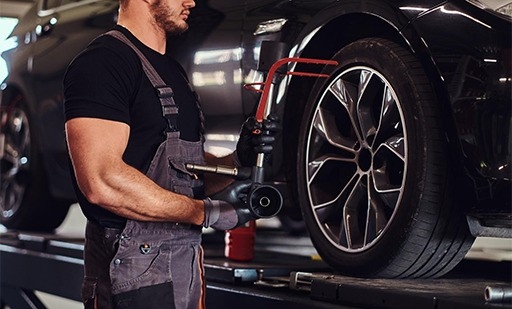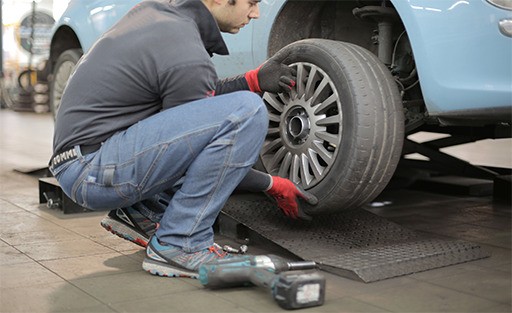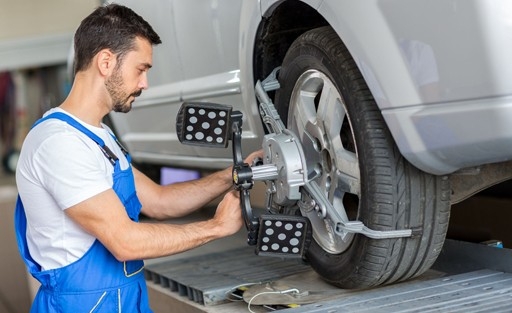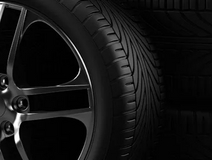
March 15, 2023
Wheel Maintenance Basics

Wheels are one of the most critical parts of your vehicle, as they help convert the engine's power into movement and serve as the point of contact between your car, your tyres, and, ultimately, the road. Every time you press the accelerator, the engine pushes power down into the wheels through the drivetrain. They then spin freely while still attached to your vehicle, propelling it forward. They are also where you connect your tyres, which ensures a safe and comfortable ride.
Keeping your wheels in good condition is essential for staying safe on the road, and this post will cover important wheel maintenance tips to help you keep them in top shape.
Why Maintain Your Wheels?
Maintaining your wheels in good condition is essential for several reasons:
-
Safety: A damaged or worn wheel can compromise your vehicle's handling and stability, increasing the risk of accidents or loss of control. Loose or missing bolts can cause your wheels to wobble or even come off, which is extremely dangerous.
-
Performance: Worn or misaligned wheels can cause your vehicle to pull to one side, vibrate or shake, and negatively affect your steering and braking performance. On the other hand, properly maintained wheels can improve your vehicle's handling, stability, and fuel efficiency.
-
Durability: Your wheels are exposed to harsh conditions, including extreme temperatures, road salt, and debris. Without proper maintenance, your wheels can develop corrosion, cracks, or other forms of damage, which can reduce their lifespan and lead to costly repairs or replacements.
-
Appearance: Let's face it, a set of clean, shiny wheels can make your vehicle look really good! Regular cleaning and maintenance can help preserve the appearance of your wheels and make them look like new ones for longer.
Inspecting Your Wheels
Before you start maintaining your wheels, knowing what to look for when inspecting them is crucial. Here are a few things to keep an eye on:

-
Signs of damage: Wheels can be subjected to all sorts of damage from hitting potholes, curbs, or other obstacles in the road. Look for cracks, dents, or other signs of damage that could compromise the integrity of your wheels. If you notice any damage, it's vital to address it immediately. Driving with broken-down wheels can be dangerous and cause further issues to your vehicle.
-
Wear and tear: Over time, your wheels can develop scratches, patches and other signs of wear and tear. While these may not compromise the structural integrity of your wheels, they can impact the appearance of your vehicle. Keeping an eye on these surface changes will also help you know when to replace your wheels. Depending on the severity, it can also lead to a decrease in fuel efficiency, increased vibration, or even loss of traction, which can all impact your safety.
-
Loose or missing bolts: The bolts that hold your wheels to the hub can sometimes get loose over time. Loose or missing bolts can cause your wheels to wobble or even come off - especially mid-drive! So it's vital to check if they are securely in place. Don't just look at the bolts; inspect, feel, and tighten them if necessary. If any bolts are missing, replace them as soon as possible.


By regularly checking for signs of damage, wear and tear, and loose or missing bolts, you can help ensure that your wheels are in good condition and that your vehicle is safe to drive.
Cleaning Your Wheels
Keeping your wheels clean is also an essential part of maintaining them. Not only does it help keep them looking shiny and new but it can also prevent dirt and grime buildup that can lead to corrosion or other damage. Here are the steps you can follow in cleaning your wheels:

-
Materials: You'll need a:
✓ bucket of water
✓ mild soap
✓ a sponge
✓ a soft-bristled brush
✓ a microfiber towel
Avoid harsh chemicals or abrasive cleaners, as they can damage your wheels.
-
Steps to follow for cleaning: Start by rinsing your wheels with water to remove any loose dirt or debris. This will help prevent scratching the wheels during the cleaning process. Next, use the sponge to apply the soap and gently scrub, starting at the top and working your way down. Pay extra attention to the areas around the lug nuts and the edges of the wheels, as these areas can be challenging to clean. Use the soft-bristled brush to remove any dirt or grime from hard-to-reach areas.
-
Rinse and dry: After cleaning the wheels, rinse them thoroughly with clean water to remove any soap residue. Then, use the microfiber towel to dry them off. Be sure to dry the wheels completely to prevent water spots from forming.
PRO-TIP: To keep your wheels looking their best, apply a wheel wax or sealant after cleaning them. This will help protect them from dirt and grime and keep them looking shiny. Be sure to choose a product specifically designed for use on wheels, as some types of wax or sealant can damage the finish on your wheels.
Following these steps and regularly cleaning your wheels can help keep them in top condition and extend their lifespan. It's a simple task that can make a big difference in the appearance and performance of your vehicle.
Tyre Maintenance
Since they work in tandem with your wheels, taking care of your tyres is also essential to maintaining your wheels. When your tyres are in the best condition, you've already increased your vehicle's and passengers' safety levels. Here are some quick tyre maintenance tips we suggest you incorporate into your weekly routine.
1. Tyre pressure: Check your tyre's air pressure regularly. Underinflated tyres can reduce fuel efficiency but, even worse, increase the risk of blowouts. You can easily do this at any petrol station or use a tyre pressure gauge to check the pressure and add air as needed. You can find the recommended tyre pressure for your vehicle in your owner's manual or on the tyre placard inside the driver's door or glove box.
2. Tread depth: The tread on your tyres provides grip and traction, especially in wet or slippery conditions. As the tread wears down, your tyre's ability to grip the road decreases, increasing the risk of accidents. The legal tread limit in Australia is 1.4mm, but we recommend you replace your tyre when it is about 2.5 to 3mm. Use a tread depth gauge to measure your tyre's current tread, or read more about tyre tread depth tips here.
3. Tyre Rotation: All vehicle tyres wear down at different rates depending on their position. This is why it's important to rotate your tyres regularly to ensure even tread wear and a prolonged life span. Aim to rotate your tires every 5,000 to 8,000 kilometres or as often as your vehicle's manufacturer recommends.
4. Wheel alignment: Proper wheel alignment is critical to maintaining the stability and handling of your vehicle. Misaligned wheels can cause uneven tyre wear, affect fuel efficiency, and make your car more difficult to control. Signs of misalignment include a vibrating or an off-centre steering wheel or if your vehicle constantly pulls more to one side. If you notice these signs, take your car to a trusted mechanic to align the wheels.

Keeping Your Wheels Rolling Smoothly
Your wheels are an important part of your vehicle; maintaining them is essential for staying safe. Following these wheel maintenance basics lets you keep your wheels in shape and enjoy a smooth, safe ride.
Remember to inspect your wheels regularly, clean them, maintain your tyres, and get your wheels aligned as needed. By doing so, you can extend the life of your wheels and keep your vehicle running smoothly.
If you need new wheels, don't hesitate to upgrade your ride with Tyroola. Browse our high-quality wheel selection and order for fast and reliable delivery.



